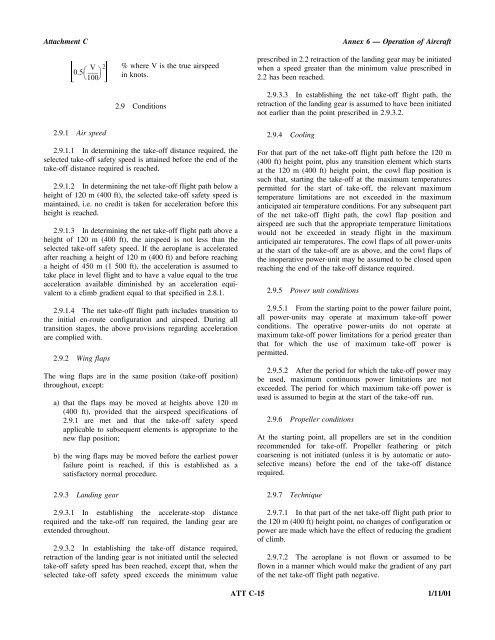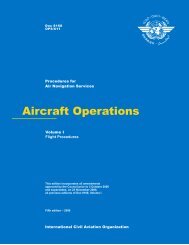Operation of Aircraft
Annex 6, Part I
Annex 6, Part I
- No tags were found...
You also want an ePaper? Increase the reach of your titles
YUMPU automatically turns print PDFs into web optimized ePapers that Google loves.
Attachment C<br />
0.5⎛ V ⎞ 2<br />
⎝100⎠<br />
% where V is the true airspeed<br />
in knots.<br />
2.9 Conditions<br />
Annex 6 — <strong>Operation</strong> <strong>of</strong> <strong>Aircraft</strong><br />
prescribed in 2.2 retraction <strong>of</strong> the landing gear may be initiated<br />
when a speed greater than the minimum value prescribed in<br />
2.2 has been reached.<br />
2.9.3.3 In establishing the net take-<strong>of</strong>f flight path, the<br />
retraction <strong>of</strong> the landing gear is assumed to have been initiated<br />
not earlier than the point prescribed in 2.9.3.2.<br />
2.9.1 Air speed<br />
2.9.4 Cooling<br />
2.9.1.1 In determining the take-<strong>of</strong>f distance required, the<br />
selected take-<strong>of</strong>f safety speed is attained before the end <strong>of</strong> the<br />
take-<strong>of</strong>f distance required is reached.<br />
2.9.1.2 In determining the net take-<strong>of</strong>f flight path below a<br />
height <strong>of</strong> 120 m (400 ft), the selected take-<strong>of</strong>f safety speed is<br />
maintained, i.e. no credit is taken for acceleration before this<br />
height is reached.<br />
2.9.1.3 In determining the net take-<strong>of</strong>f flight path above a<br />
height <strong>of</strong> 120 m (400 ft), the airspeed is not less than the<br />
selected take-<strong>of</strong>f safety speed. If the aeroplane is accelerated<br />
after reaching a height <strong>of</strong> 120 m (400 ft) and before reaching<br />
a height <strong>of</strong> 450 m (1 500 ft), the acceleration is assumed to<br />
take place in level flight and to have a value equal to the true<br />
acceleration available diminished by an acceleration equivalent<br />
to a climb gradient equal to that specified in 2.8.1.<br />
2.9.1.4 The net take-<strong>of</strong>f flight path includes transition to<br />
the initial en-route configuration and airspeed. During all<br />
transition stages, the above provisions regarding acceleration<br />
are complied with.<br />
2.9.2 Wing flaps<br />
The wing flaps are in the same position (take-<strong>of</strong>f position)<br />
throughout, except:<br />
a) that the flaps may be moved at heights above 120 m<br />
(400 ft), provided that the airspeed specifications <strong>of</strong><br />
2.9.1 are met and that the take-<strong>of</strong>f safety speed<br />
applicable to subsequent elements is appropriate to the<br />
new flap position;<br />
b) the wing flaps may be moved before the earliest power<br />
failure point is reached, if this is established as a<br />
satisfactory normal procedure.<br />
2.9.3 Landing gear<br />
2.9.3.1 In establishing the accelerate-stop distance<br />
required and the take-<strong>of</strong>f run required, the landing gear are<br />
extended throughout.<br />
2.9.3.2 In establishing the take-<strong>of</strong>f distance required,<br />
retraction <strong>of</strong> the landing gear is not initiated until the selected<br />
take-<strong>of</strong>f safety speed has been reached, except that, when the<br />
selected take-<strong>of</strong>f safety speed exceeds the minimum value<br />
For that part <strong>of</strong> the net take-<strong>of</strong>f flight path before the 120 m<br />
(400 ft) height point, plus any transition element which starts<br />
at the 120 m (400 ft) height point, the cowl flap position is<br />
such that, starting the take-<strong>of</strong>f at the maximum temperatures<br />
permitted for the start <strong>of</strong> take-<strong>of</strong>f, the relevant maximum<br />
temperature limitations are not exceeded in the maximum<br />
anticipated air temperature conditions. For any subsequent part<br />
<strong>of</strong> the net take-<strong>of</strong>f flight path, the cowl flap position and<br />
airspeed are such that the appropriate temperature limitations<br />
would not be exceeded in steady flight in the maximum<br />
anticipated air temperatures. The cowl flaps <strong>of</strong> all power-units<br />
at the start <strong>of</strong> the take-<strong>of</strong>f are as above, and the cowl flaps <strong>of</strong><br />
the inoperative power-unit may be assumed to be closed upon<br />
reaching the end <strong>of</strong> the take-<strong>of</strong>f distance required.<br />
2.9.5 Power unit conditions<br />
2.9.5.1 From the starting point to the power failure point,<br />
all power-units may operate at maximum take-<strong>of</strong>f power<br />
conditions. The operative power-units do not operate at<br />
maximum take-<strong>of</strong>f power limitations for a period greater than<br />
that for which the use <strong>of</strong> maximum take-<strong>of</strong>f power is<br />
permitted.<br />
2.9.5.2 After the period for which the take-<strong>of</strong>f power may<br />
be used, maximum continuous power limitations are not<br />
exceeded. The period for which maximum take-<strong>of</strong>f power is<br />
used is assumed to begin at the start <strong>of</strong> the take-<strong>of</strong>f run.<br />
2.9.6 Propeller conditions<br />
At the starting point, all propellers are set in the condition<br />
recommended for take-<strong>of</strong>f. Propeller feathering or pitch<br />
coarsening is not initiated (unless it is by automatic or autoselective<br />
means) before the end <strong>of</strong> the take-<strong>of</strong>f distance<br />
required.<br />
2.9.7 Technique<br />
2.9.7.1 In that part <strong>of</strong> the net take-<strong>of</strong>f flight path prior to<br />
the 120 m (400 ft) height point, no changes <strong>of</strong> configuration or<br />
power are made which have the effect <strong>of</strong> reducing the gradient<br />
<strong>of</strong> climb.<br />
2.9.7.2 The aeroplane is not flown or assumed to be<br />
flown in a manner which would make the gradient <strong>of</strong> any part<br />
<strong>of</strong> the net take-<strong>of</strong>f flight path negative.<br />
ATT C-15 1/11/01












